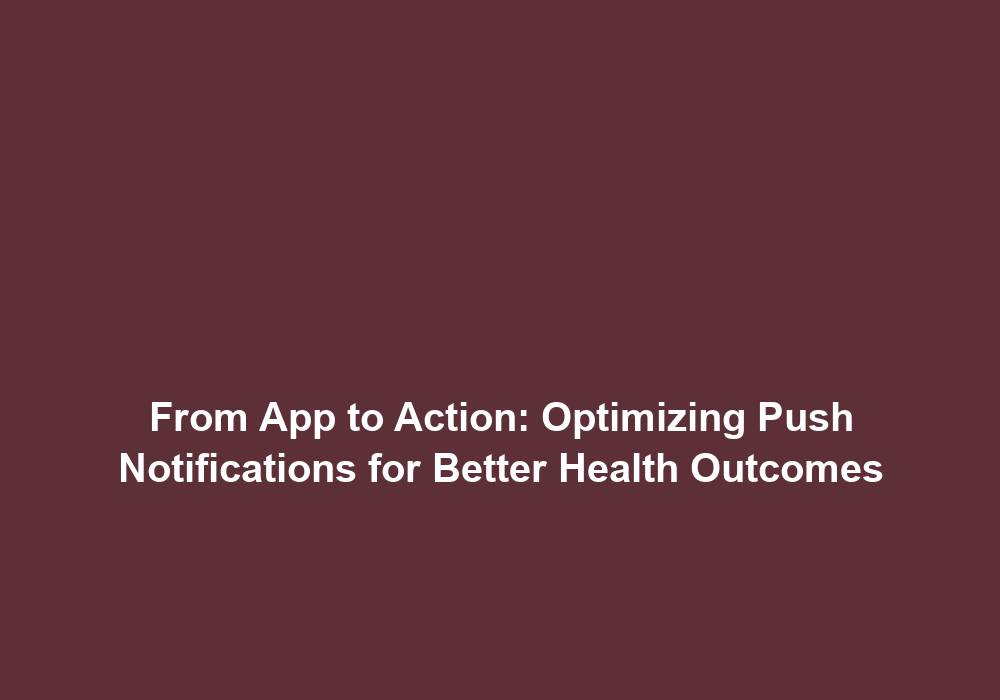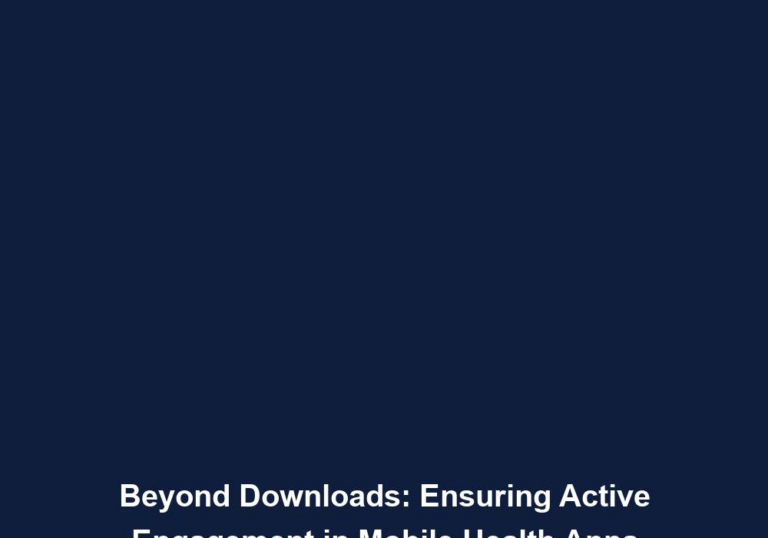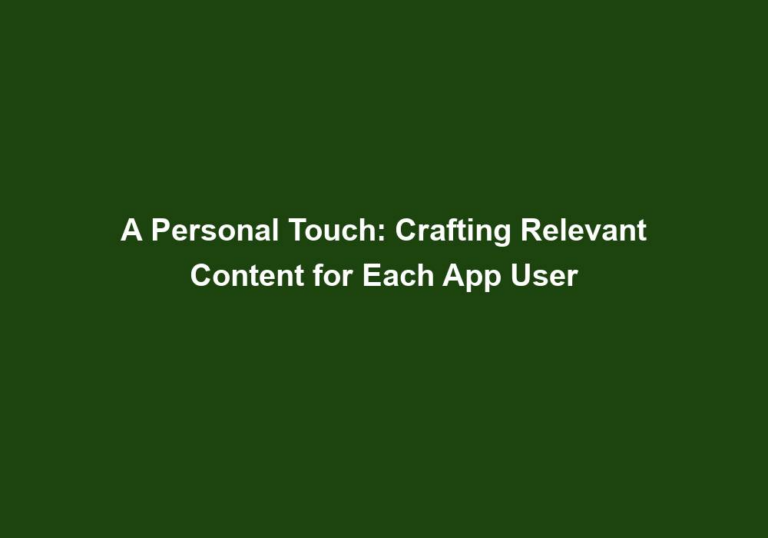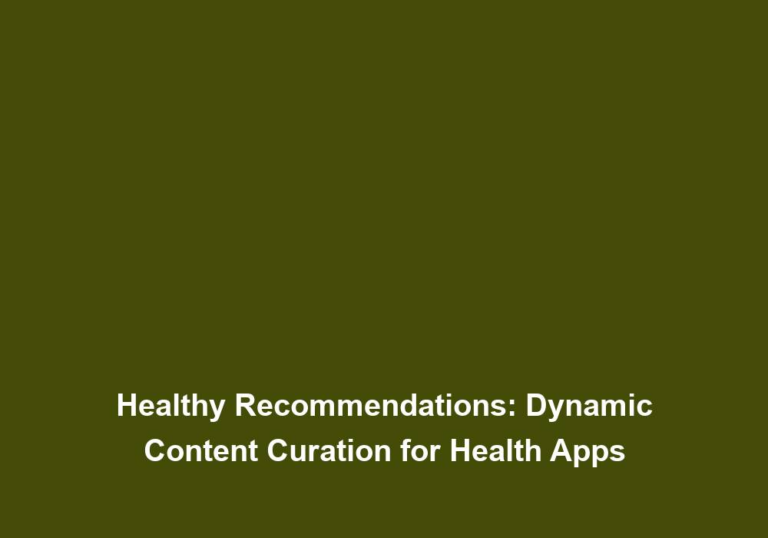From App to Action: Optimizing Push Notifications for Better Health Outcomes
In the fast-paced world of mobile applications, push notifications have become an integral part of engaging users and driving action. For healthcare apps, the potential impact of well-optimized push notifications is even more significant, as they can play a crucial role in improving health outcomes and promoting healthier behaviors. In this article, we will explore the key strategies to optimize push notifications for better health outcomes.
Understanding the Power of Push Notifications
Push notifications are messages delivered directly to the user’s mobile device, even when they are not actively using the app. This makes them an effective way to drive user engagement and encourage specific actions. In the context of healthcare apps, push notifications can be leveraged to remind users to take their medication, track their health progress, schedule appointments, and even provide personalized health advice.
Push notifications have the power to reach users in real-time, ensuring that important health-related information is not missed. By delivering notifications directly to the user’s device, even when they are not actively using the app, healthcare apps can provide timely reminders and updates. For example, a medication reminder can be sent at the scheduled dosage time, prompting the user to take their medication on time. This can greatly improve medication adherence and overall health outcomes.
Personalization and Relevance
To optimize push notifications for better health outcomes, personalization and relevance are paramount. By tailoring notifications to each user’s specific needs and preferences, you can significantly increase their effectiveness. Here are some key strategies to achieve personalization and relevance:
1. User Segmentation
Segmenting your user base based on factors such as age, gender, health conditions, and preferences allows you to deliver more targeted and personalized notifications. For example, sending medication reminders to users who have chronic conditions or providing exercise tips to individuals interested in fitness.
User segmentation enables healthcare apps to deliver notifications that are tailored to the specific needs of each individual user. By categorizing users based on relevant factors, such as their health conditions or fitness goals, apps can send notifications that are highly relevant and resonate with the user. This not only improves the user experience but also increases the likelihood of user engagement and action.
2. Behavioral Analysis
Leveraging the data collected from user interactions within the app, you can analyze their behavior patterns and preferences. This analysis enables you to send notifications at the right time, prompting users to take action when they are most likely to be receptive. For instance, sending a reminder to track their daily steps in the evening when they usually engage in physical activities.
By analyzing user behavior patterns, healthcare apps can gain valuable insights into when users are most likely to engage with the app and take action. For example, if the app records that a user consistently logs their meals and exercises in the evening, a push notification encouraging them to track their daily steps in the evening would be more effective. This personalized and timely approach increases the chances of user engagement and adherence to healthier behaviors.
3. Customization Options
Providing users with customization options empowers them to tailor the notifications according to their preferences. This allows them to choose the frequency, timing, and types of notifications they receive. By giving users control, you ensure that they perceive the notifications as helpful rather than intrusive.
Customization options give users the flexibility to personalize their app experience based on their preferences and needs. For example, users can choose to receive medication reminders at specific times or opt for weekly progress updates instead of daily ones. This customization not only enhances the user experience but also increases the likelihood of user engagement and adherence to the app’s recommendations.
Crafting Compelling and Action-Driven Messages
The content of your push notifications is the key driver of user engagement and action. To optimize push notifications for better health outcomes, it is essential to create compelling and action-driven messages. Here are some guidelines to consider:
1. Clear and Concise Language
Keep your notifications concise, using clear and straightforward language. Users should be able to understand the message at a glance. Avoid using jargon or complex medical terminology that may confuse or alienate users.
Clear and concise language is crucial for effective communication through push notifications. Users often skim through their notifications, so it is important to convey the message in a concise and easily understood manner. By using simple and jargon-free language, healthcare apps can ensure that users grasp the message quickly and take the desired action.
2. Urgency and Call-to-Action
Incorporate a sense of urgency in your notifications to prompt immediate action. Use action verbs and clear call-to-action statements to encourage users to take the desired steps. For example, It’s time to take your medication! Tap here to mark it as done.
Creating a sense of urgency in push notifications can motivate users to take immediate action. By using action verbs and clear call-to-action statements, healthcare apps can prompt users to perform the desired action without delay. This can be particularly effective for medication reminders or time-sensitive health advice.
3. Personalized Recommendations
Tailor recommendations based on the user’s health profile and previous interactions with the app. By providing personalized suggestions, such as healthy recipes or exercise routines, you can foster healthier behaviors and increase engagement.
Personalized recommendations add value to push notifications by offering users relevant and actionable suggestions. By leveraging the user’s health profile and app interactions, healthcare apps can provide recommendations that align with the user’s goals and preferences. This personalization not only increases user engagement but also contributes to long-term behavior change and improved health outcomes.
4. Emotional Appeal
Using emotions can be a powerful tool to motivate users to take action. Craft notifications that evoke positive emotions, such as encouragement, inspiration, or empathy. For instance, You’re doing great! Keep up the good work on your fitness journey.
Emotional appeal can significantly impact user engagement and motivation. By crafting push notifications that evoke positive emotions, healthcare apps can create a supportive and encouraging environment for users. This can boost user morale, inspire them to continue their health journey, and ultimately lead to better health outcomes.
Timing and Frequency
The timing and frequency of push notifications can greatly impact their effectiveness. A well-timed notification can catch the user’s attention and prompt immediate action. On the other hand, excessive or poorly timed notifications can be perceived as annoying or intrusive, leading to reduced engagement. Here are some best practices for timing and frequency:
1. Optimal Timing
Consider the user’s daily routine and habits when scheduling notifications. Sending reminders or prompts during relevant times, such as mealtimes for medication reminders or mornings for exercise suggestions, can enhance the chances of user action.
Optimal timing is crucial for maximizing the impact of push notifications. By aligning notifications with the user’s daily routine and habits, healthcare apps can increase the likelihood of user engagement. For example, sending a medication reminder during mealtimes ensures that the user is more likely to take their medication as prescribed.
2. Avoid Overload
Avoid bombarding users with too many notifications, as this can lead to notification fatigue. Find the right balance between keeping users informed and respecting their boundaries. Allow users to choose their preferred frequency, ensuring they receive notifications that align with their needs and preferences.
Notification overload can be counterproductive and lead to user disengagement. It is important to strike a balance between providing necessary information and overwhelming the user with notifications. By allowing users to customize the frequency of notifications, healthcare apps can ensure that users receive relevant updates without feeling overwhelmed or annoyed.
3. Testing and Iteration
Continuously monitor and analyze user engagement with push notifications to identify optimal timing and frequency. A/B testing can be used to experiment with different schedules and iterate based on the insights gained. This iterative approach allows you to tailor the timing and frequency to maximize user responses.
Testing and iteration are essential for optimizing the timing and frequency of push notifications. By monitoring user engagement and analyzing the impact of different notification schedules, healthcare apps can refine their approach over time. A/B testing can provide valuable insights into user preferences and help fine-tune the timing and frequency to maximize user responses.
Conclusion
Optimizing push notifications for better health outcomes requires a thoughtful approach that takes into account personalization, relevance, content, timing, and frequency. By implementing these strategies, healthcare app developers can effectively engage users, drive action, and ultimately contribute to improved health outcomes. Remember, the power lies in delivering the right message, to the right user, at the right time.





